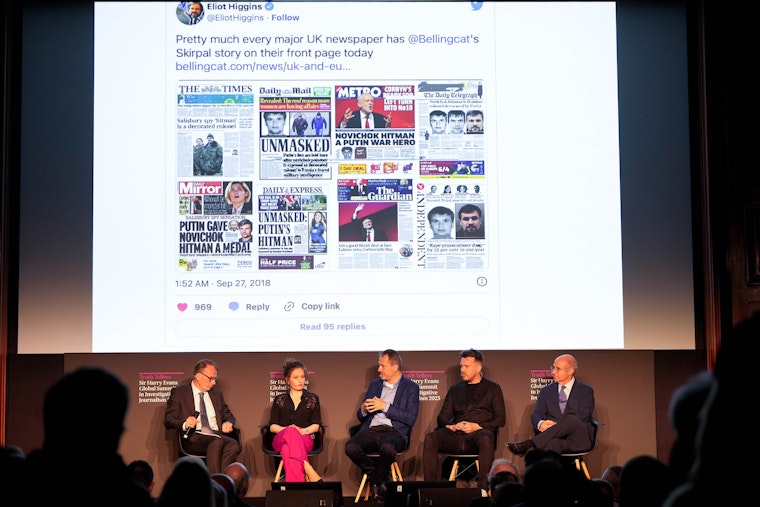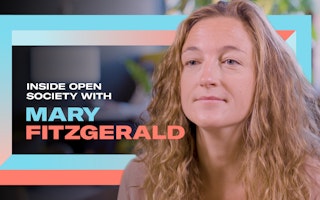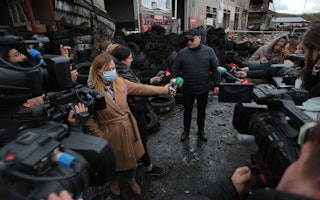Q&A: How Open Source Evidence Is Challenging Abuses, Atrocities, and Disinformation

Bellingcat is an independent investigative collective of researchers, investigators, and journalists based in Amsterdam. Founded 10 years ago, Bellingcat has pioneered the use of open-source research to expose human rights abuses, atrocity crimes, and high-level corruption and other criminal activities involving governments, underworld gangs, and other illicit actors. Among its high-profile investigations, it detailed the role of Russian military intelligence in both the 2018 attempt to assassinate Sergei Skirpal in Salisbury, England, and in the August 2020 poisoning in Russia of Alexei Navalny, the Russian opposition figure who died in prison this year.
We spoke with Eliot Higgins, founder and a director of Bellingcat, about working with mainstream media, the challenge of disinformation and conspiratorial thinking, and how open-source material is playing a part in international justice.
You collaborate with some of the most prestigious media outlets in the world. What’s been your experience of partnering with traditional media?
Even years back, there were journalists who were working on specific topics like Syria or Ukraine who really saw the value of the work we were doing because they could actually check our findings and follow up on the ground. But it was more the culture of journalism that had to change. Collaboration was not something a lot of news organizations like doing. For Bellingcat, collaboration is really, really, important because it brings many people in our network together who have knowledge of these topics to work on something we have a common interest in, and then enables them to publish through more traditional media outlets. Through collaboration, we are reaching audiences we wouldn’t normally be able to reach.
Tell us about the work of of Bellingcat’s Justice and Accountability Unit.
For the last four years, we’ve been developing a process that’s specifically intended for use in international courts. The one question that was on a lot of minds eight or nine years ago was, how do you get the physical evidence of this? But really, the legal community now has come to see that you don’t necessarily need physical evidence because there are multiple other ways to verify whether a video or photograph is taken in the place it claims to be. Often, it’s not just about one video or photograph, but a whole nexus of information around an incident that you’re exploring. We’ve developed a whole process now where we’ve been sharing information with the International Criminal Court on Ukraine about complex conflict incidents. Open-source evidence is a really big part of this. It really helps complement other types of investigative work, witness statements, evidence gathered from the ground, when you have a vast amount of open-source data to support that.

Tell us about the Discord community which has emerged from Bellingcat?
The Discord community is a really great place where people can come together, have good discussions that are fact-based, find evidence, and share information. And there are investigations that emerge from that community such as a recent series of articles we've published on an oil spill off the coast of Trinidad and Tobago. Our Discord community led the way in the investigation—finding answers about which vessel was involved in the oil spill, where it originated, the ownership of the vessel, and other information that played a crucial role in identifying who was responsible for the oil spill that likely wouldn’t have been answered elsewhere.
Does the medium in which people access content make it more difficult to combat disinformation or conspiratorial thinking?
Over the last 15 years, we’ve seen a massive shift in how we consume information and access information, and that particularly affects young people. A lot of counter disinformation work is: how do you spot if a headline is fake? But young people aren’t seeing headlines, they’re seeing TikTok videos. They aren’t reading newsreels. I think we have to understand the dynamics and a lot of the reason people are drawn to disinformation is that they are feeling insecure; they feel betrayed by some mainstream source of authority.
What causes some online communities to become absorbed in conspiracy theories online, particularly given the evidence to the contrary?
Some people go through life experiences—it could be a political experience, a personal experience—where they feel betrayed by a source of authority, but it becomes so severe that it becomes the lens through which they see the entire world. A good example is when you look at people who say chemical weapons attacks aren’t happening in Syria. It’s because they’re looking at 2003 and the invasion of Iraq—and the absence of the weapons of mass destruction that Washington claimed were there—as a real formative experience in their understanding of politics and how the world works. So, it’s very easy for them to say, “it’s just Iraq all over again.” And then you’ll search and find online communities who agree with you, and it just reinforces that idea and acts to radicalize you to a certain extent.
Are there certain topics or political contexts where audiences are particularly skeptical?
I think really wherever you’re looking, you’ll always find those communities that are counterfactual communities, the ones who are the denialists on any topic under the sun, from chemical weapons to Syria to whether the Earth is flat. If you look at the core motivators, the psychology is very often the same. It’s just on different topics. So, I wouldn’t say it’s really any different from what we’re seeing in Ukraine or the Middle East or anywhere else. It’s the same dynamics happening; just on different topics.
What impact does the current social media environment, and particularly the changes on X/Twitter, mean for your work?
Bellingcat is primarily on Twitter. We’ve expanded onto other social media platforms as they’ve fragmented into different directions. We’re not on Truth Social or TikTok, but we are on Mastodon and others. It’s not so much that it makes Bellingcat's work harder, but it creates a lot of noise. And you also see a reflection, especially on Twitter, of how effectively grifting—profiting from churning out false material or spreading hate—is now being rewarded because of the changes that have been made to the platform.
If you look at Israel and Gaza and some of the fastest growing accounts around that, they are the accounts that are spreading disinformation. And Twitter is now designed to reward those people.
Listen to more from Eliot Higgins on the latest episode of What's Wrong with Democracy?, a podcast produced by Tortoise Media and supported by the Open Society Foundations.


